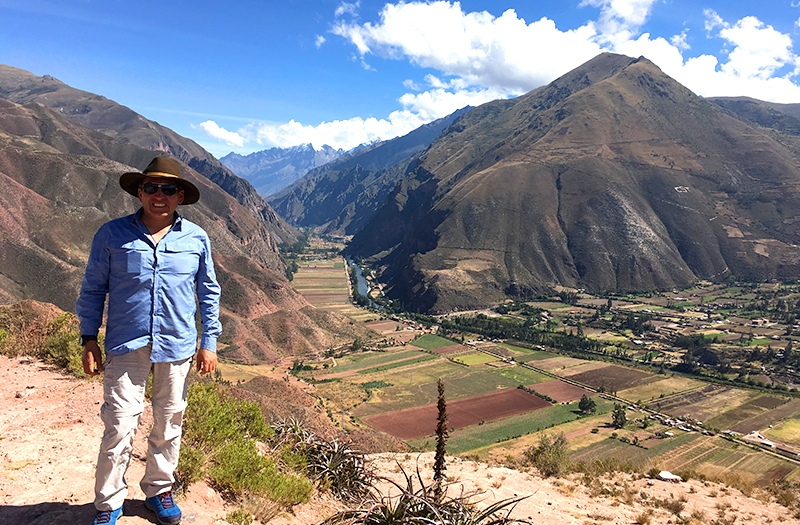Sacred Valley Plus Pisaq Ruins
PROGRAM: Cultural, Archaeological.
DURATION: Customize
GROUP SIZE: 1 – 7
DEPARTURE: Every day.
FREQUENCY: All year
One of the most spectacular views of the Sacred Valley of the Incas is definitely the Pisac archaeological site. Located in the province of Calca, town of Pisac, Cusco, this archaeological site is one of the most important and visited for its architectural beauty. It is a compulsory tourist point in the route of the Sacred Valley of the Incas.
The ruins are 25 minutes from the town of Pisac, following the path up the side of the mountain. In the archaeological complex, you can see overlapping terraces, ceremonial baths, a residential settlement, and the largest known Inca cemetery, the oldest in South America. Down the hill is a complex of temples carved from pink granite, a place that stands out for its ceremonial altars, water wells, and the beautiful temple of the sun. The ruins are surrounded by wide agricultural terraces that merge with the curvature of the mountain.
Platforms, towers and neighborhoods of Pisac
It is important to note that the Pisac archaeological site has platforms, towers and neighborhoods. Regarding the first, we have the Acchapata group of platforms, a set of terraces that rises just 200 meters from the town square of Pisac. There are 40 platforms that form an inverted triangle, that is, the smallest platform can be seen when starting to ascend.
On the towers, Pisac has more than 20 specimens of two types: room towers and watchtower towers. The former have a conical shape and are connected to water channels built with carved and assembled parts. The watchtowers are not considered enclosures, but are compact mass elevations with a conical tendency, the most important being the one found in the Qoriwayrachina sector.
Some of the most prominent neighborhoods in the archaeological zone is Intiwatana, which is the main neighborhood, housing finely built temples and palaces. Its enclosures are the largest of all the neighborhoods and it has three levels, its buildings are directed towards the valley. In this place is the “Intiwatana”, an altar carved out of a volcanic crevice, liturgical sources, streets and patios. Another neighborhood in Písac is that of Tianayuc, which is a small neighborhood, whose doors to its rooms open onto a central patio. We also have the neighborhood of K´alla Q´asa, which was built on the top of the mountain and at a higher altitude than the other enclosures, its buildings are built on an inclined plane. Here you can see rooms, turrets, and a 3 meter long tunnel. This neighborhood is built next to impressive ravines.
Pisac´a is a neighborhood that is located 200 meters from the Intiwatana neighborhood, the same one that was built lowering the original level of the land, in order to achieve a small plain. This neighborhood has a semicircular shape, in harmony with the circumference of the mountain, here there are more than 20 rooms, built in a precise order. Finally, we have the Qanchis Raqay neighborhood, which has many buildings made of medium and small stones, being built on an inclined plane, up to where the Chongo stream is. This neighborhood is a kind of checkpoint, guarding the northeast side of the city of Pisac.
About the Sacred Valley of the Incas
Known to the Incas as Willcamayu, the beautiful Sacred Valley of the Incas stretches from the town of Pisac to Ollantaytambo, along the Urubamba River. The ancient Inca settlements in these cities are presented as checkpoints, before entering the “Inca trail” that leads to the sacred city: Machu Picchu.
The tour of the sacred valley is a markedly traditional route, where the visitor will meet Quechua-speaking residents, in typical costumes, working in their fields in an artesanal way, passing through villages built in colonial times and through ancient settlements Inca. It will visit markets, temples and city squares. It is important to note that the Sacred Valley of the Incas is made up of Pisac, Urubamba, Ollantaytambo, Chinchero, Maras, Moray and Yucay.
It includes :
- Pick up from the hotel.
- Private transport.
- Professional bilingual guide.
The tour DOES NOT INCLUDE:
- Tourist ticket. (BTG)
- Meals.
It is recommended to bring:
- Photographic camera or video camera. (Optional)
- Sunglasses, sunscreen, caps or hats.
- Light clothing.
- Warm clothes (from May, june, july, august and september), for the others months rain layer.
- Snack.
- Extra money for shopping.
- Camera.
- Passport.
BTC (Cusco Tourist Ticket, allows you to enter Pisaq , Ollantaytambo, Chinchero, and 13 other attractions include museums and 4 archaeological groups that are visited on the City Tour) S /. 130.00 or USD 47.00 only these three places. Click to see Tourist Ticket of Cusco Children and students have a 50% discount on the integral BTC.






